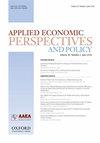如何解释大米出口?对主要大米出口国的分析
IF 3.4
2区 经济学
Q2 AGRICULTURAL ECONOMICS & POLICY
引用次数: 0
摘要
本研究考察了大米贸易的驱动因素。该分析使用了标准的比较优势模型,即Heckscher-Ohlin-Vanek (HOV)框架,并辅以引力型方程。利用泊松拟极大似然(PPML)对2002 ~ 2020年的数据进行估计,分析结果基本证实了HOV模型的预测。结果表明,耕地面积、GDP、距离、降水和作物季节温度对水稻贸易动态有显著影响。结果表明,影响水稻贸易的主要因素是降水,而非蓝水供应。然而,农业用水压力阻碍了出口,鼓励了进口。本文章由计算机程序翻译,如有差异,请以英文原文为准。
What explains rice exports? An analysis of major rice-exporting countries
This study examines the drivers of rice trade. The analysis uses the standard comparative advantage model, the Heckscher–Ohlin–Vanek (HOV) framework, supplemented with a gravity-type equation. Using the Poisson pseudo-maximum likelihood (PPML) estimation for data from 2002 to 2020, the analysis broadly confirms HOV model predictions. Results indicate that arable land, along with GDP, distance, precipitation and crop season temperature, significantly influences rice trade dynamics. The results showed that the precipitation play a key role in influencing the rice trade rather than the blue water availability. However, agricultural water stress discouraged exports and encouraged imports.
求助全文
通过发布文献求助,成功后即可免费获取论文全文。
去求助
来源期刊

Applied Economic Perspectives and Policy
AGRICULTURAL ECONOMICS & POLICY-
CiteScore
10.70
自引率
6.90%
发文量
117
审稿时长
>12 weeks
期刊介绍:
Applied Economic Perspectives and Policy provides a forum to address contemporary and emerging policy issues within an economic framework that informs the decision-making and policy-making community.
AEPP welcomes submissions related to the economics of public policy themes associated with agriculture; animal, plant, and human health; energy; environment; food and consumer behavior; international development; natural hazards; natural resources; population and migration; and regional and rural development.
 求助内容:
求助内容: 应助结果提醒方式:
应助结果提醒方式:


